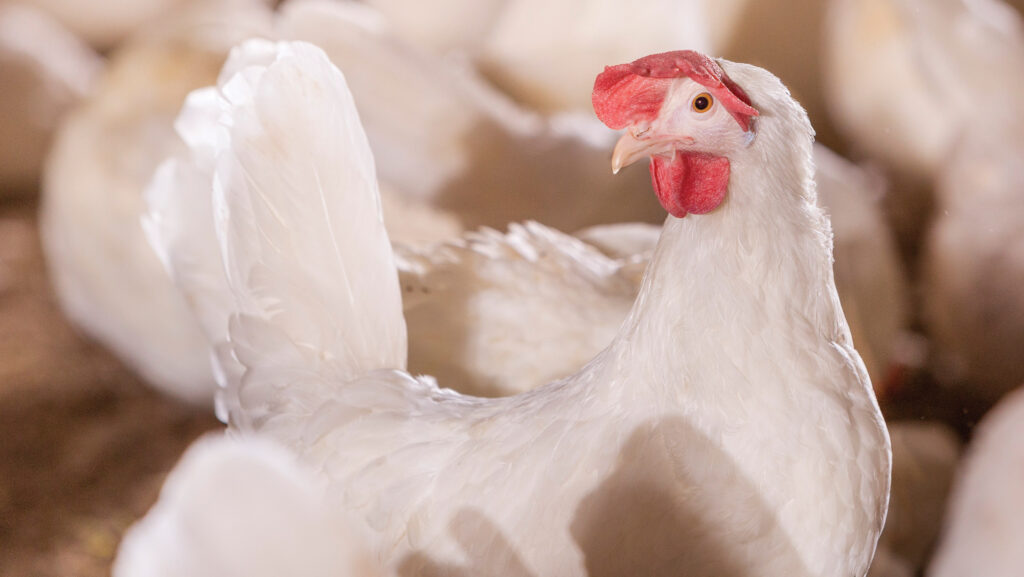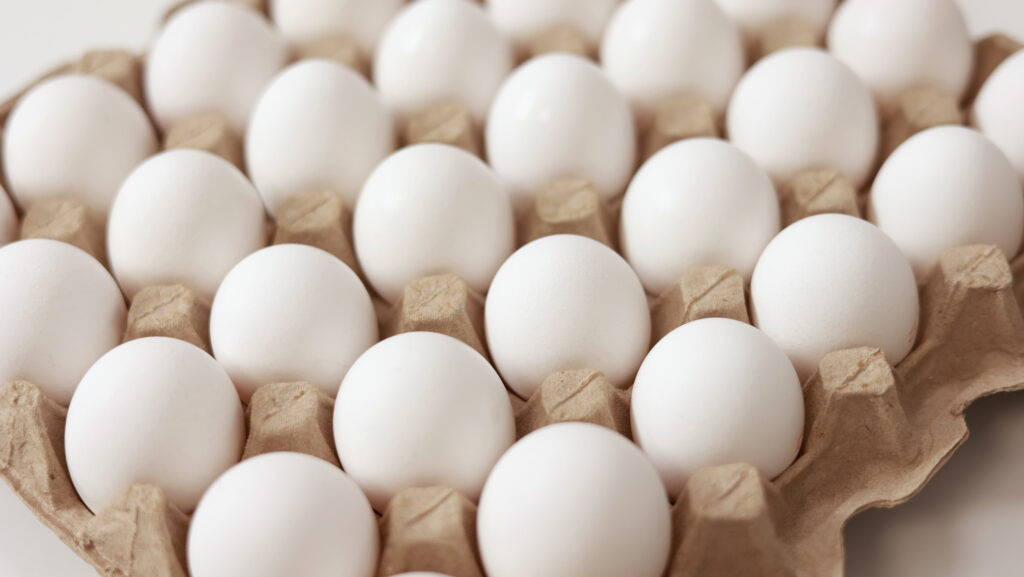Why white hens could make a comeback
 © Joice and Hill Poultry
© Joice and Hill Poultry White hens make up just 8% of the UK’s egg output. But with laying cycles of 100 weeks possible in some breeds and sustainability credentials that tick boxes for retailers and consumers, there is scope for increased production.
At Plas Llanynys, Denbighshire, the farm’s second flock of 28,000 free-range White Leghorns achieved a laying cycle of 98 weeks – 26 weeks longer than the average across all UK free-range egg systems.
See also: Advice on free-range layer rations, stage by stage
With an average of 491.6 eggs produced a bird, a 5.52% mortality rate and an egg size of 61.6g, the flock delivered the efficiency goals the business is targeting.
The Dekalb White flock (one of several white breeds used in UK free-range egg production) was depleted at the end of April 2024, and the incoming flock will also be white hens.
The business, a multi-tier Big Dutchman system run by Tom Jones, his mother, Debbie, and stepfather, Rob Halford, was established on their former dairy farm in 2021.
They opted for a 28,000-bird system instead of the more usual 32,000 because of limitations with land.
Benefits of longer laying cycles
- More eggs a bird
- Reduction in pullet depreciation
- Less frequent restocking
- Reduced turnaround cost
- Less downtime for infrastructure
- Fewer vehicle movements
“The first flock was excellent right from the start, achieving 98.5% at peak of production, so we were gutted to see them go at 94 weeks,” says Tom.
With the second flock, having learned exactly what feed and lighting regimes worked best, another four weeks was added to the laying cycle.
“The longer laying cycles mean we get extra value from the pullets,” says Tom, who sells his eggs to Stonegate.
He was attracted to the Dekalb White for other reasons, too.
“The breed offers the smallest carbon footprint through superior feed conversion and less resource use per egg, and that appeals to me.”
Market share
With those obvious benefits, plus the behavioural traits found in some white layers that are suited for free-range production, why does 92% of egg production in the UK still come from brown birds?
The position is largely consumer-driven and has its roots in a mistaken belief that brown eggs are healthier than white ones, explains Nick Bailey, managing director of Joice and Hill Poultry, which supplies producers with the Dekalb White and other breeds.
“Backyard producers largely kept brown hens, and there was a misconception that free range was a dozen or so of these brown birds pecking around the farmyard.”
The eggs bought at the farmgate were likely to have been brown, while those available to buy in supermarkets at that time were white.
“From there, the myth was created that white eggs were eggs produced in large-scale commercial businesses, and brown were ‘rural authentic’.
“I suspect that supermarkets seized on the differential for marketing purposes,” says Nick.
What followed was a rapid shift to brown breeds – a position that has endured since the 1970s.
Slow shift
The pandemic and the lockdown of food service businesses offered an opportunity to reacquaint the retailer consumer with white eggs as these were diverted to retail outlets to meet demand.
That started a slow but upward shift, with supermarkets now stocking white eggs in dedicated packs and in mixed-colour boxes.
There are now thought to be about three million white hens in UK egg production, and Nick is confident numbers will rise.
Supermarkets will help that push as many are now persuaded by the sustainability message, he suggests.
Another factor will be the need to replace the “value” egg lines when the voluntary ban by UK retailers on selling colony eggs comes into force in 2025.

© Adobe Stock
But Nick reckons other factors will play a part too, with producers switching to white birds for multiple reasons including cost of production, bird management, and pressure to deliver on sustainability, which is only set to increase.
“White Leghorns are genetically very different to brown layers, which are more closely related to broiler breeds,” he says.
“By happy accident, some white strains have traits that make them an ideal choice for floor systems, and they have also responded well to selection for longer cycles.”
For example, the Dekalb White has been bred for traits including behaviour, persistency, eggshell quality and carbon footprint.
Financial benefit
Performance data released by breed company Hendrix Genetics show that at 88 weeks, the number of eggs a (free-range) hen housed averages 423.3 for the Dekalb White, compared with 404.7 in one of its other birds, the Bovans Brown.
The feed conversion efficiency (FCE) of the Dekalb White is 2.25kg/kg, compared with 2.15kg/kg in the Bovans Brown.
But, over and above this, data shows that a 100-week lay is achievable in the White Leghorn, with 500 eggs a hen housed over that period.
“This ability to produce prolifically over 100 weeks with great egg quality and liveability has significant financial impact,” says Nick.
At a 100-week laying cycle, it is possible to run three flocks of white hens in a five-year period, compared with four brown flocks achieving the UK average of 78 weeks, he adds.
“It is the reduced period without production and lower pullet depreciation cost that really give white birds the advantage as we go into the second and third flocks,” he says.
This means a lower carbon footprint for eggs produced.
Carbon footprint
Research published in 2019, by Erwin Mollenhorst and Yvette de Haas at Wageningen University in the Netherlands, concluded that if breeding goals were maintained, there would be an 11.5% reduction in greenhouse gases produced by white layers, compared with 9.4% in brown ones.
White hens also had better nitrogen and phosphorous efficiency than brown hens, in part owing to better FCE, and improvements in the 10 years to 2019 had been faster in white hens.
Nick says carbon footprinting is often an important area of compliance for supply to major retailers.
“In this regard, white birds have a demonstrably lighter touch on the environment,” he suggests.
“Similarly, in terms of welfare, there is virtually no pecking and no smothering.”
Another factor that he thinks is less well recognised is how the ease of managing white birds is beneficial to staff wellbeing.
“The fact white birds are easier to manage makes for better mental health among employees and better staff morale.
“For example, picking up floor eggs is hard and unpleasant work, and white breeds such as Dekalb White are generally recognised as having very few floor eggs.”
He is convinced this has an impact on employee retention rates. “With staff hard to come by, retention is very important,” he says.
